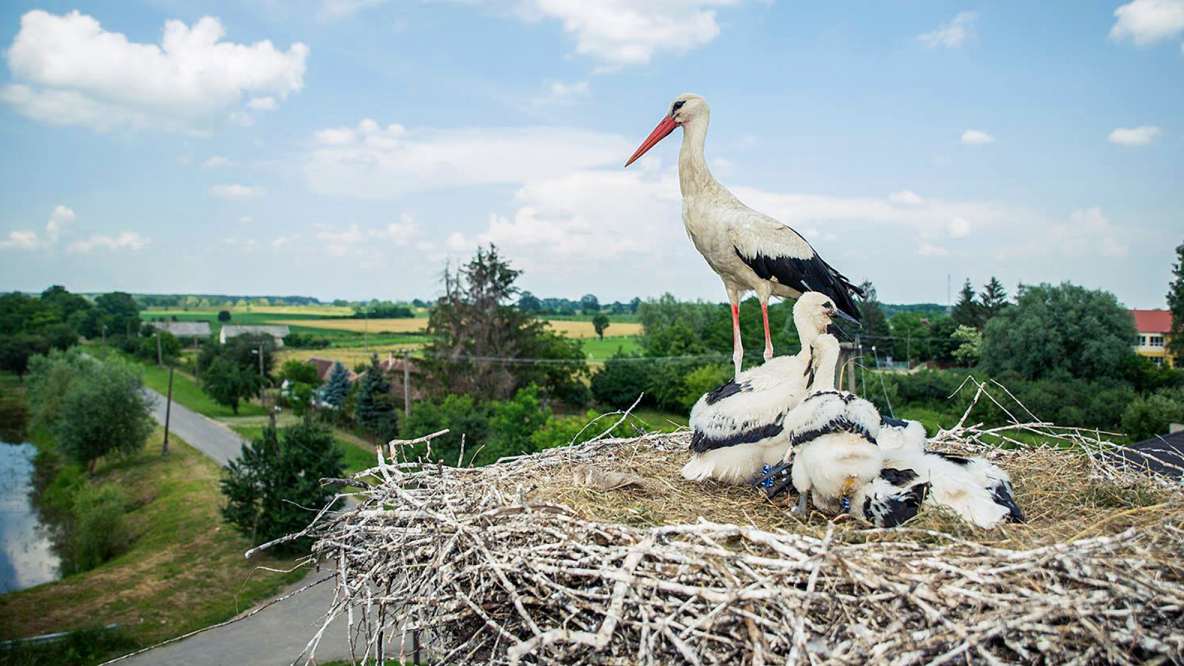When storks arrive on the scene, it’s a sure sign spring is here. Thus bringing much cheer to the remoter provinces, where these impressive birds prefer to be, in far lesser built up areas.
Although only present from March to September, these elegant, ‘sunshine birds’, hardly need an introduction, as they are instantaneous with the regions of the Central European sphere. Common white storks (‘gólyák’ in Hungarian) as many know, are highly symbolic, also they carry a graciousness and calm to Hungarian and neighbouring terrains alike, until it’s time to fly off again.
It’s a joyful sight to see them fly ‘over the Heavens’ with characteristicly slow but regular wingbeats. As well as to watch them come into land or take off from ‘new found enclosures’ on church tops, trees, chimney pots, lamp-posts, telegraph and power line poles, and purpose built structures, all within neighbourly unison with the local people. After the winter chill, egg laying soon follows.

Where to watch?
What is then essential for the well-being of these soulful birds are shallow water grounds and farmland areas providing food and vegetation. The Tisza Lake and the Hortobágyi National Park, 100-150 kms east of Budapest, are perfect breeding grounds and resource providers. Should bird-watching be of interest, I highly recommend a visit there alongside with the Bugyi (Kiskunsagi National Park) 40 kms south of the city.
The beautiful ‘sacred’ bird
The regular white storks, (Ciconia ciconia) are larger than average birds, also considered to be fairly strong. Its plumage is mainly white with black winged feathers. Adults have long red legs and long pointed red beaks. They can measure up to 100 to 115 cm from beak to tail, 155 to 215 cms with wingspan, enabling them to carry out impressive heights whilst in flight.
The nests themselves are often hard wearing, with minimal shelter, thus withstanding pressure from wind, rain, excessive sunlight and can last, with occasionally being rebuilt, for several years. The older ones can range from 1 to 2 meters in depth. 1 to 1.5 meters in diameter and anything from 60 to 200 kgs in weight and are frequently inhabited year after year.
The female usually lays a batch of 4 eggs which hatch approximately 33 days later. Both parents take turns with incubating the eggs and feeding the chicks which can continue for a further 2 months before they in turn finally fly off for the first time.
Seldom are these birds and nests obstructed by humans, due to a remarkable bond people and storks have. In Europe, they are widely viewed as sacred birds. As Legend depicts them in very touching ways, as they represent parental love, family welfare and traditionalism, as well as bringing ‘luck’ and good fortune to the neighbourhoods wherever they go.
‘Happiness and fortune’
Should a stork build a nest on top of your house, this will bring happiness and fortune. The fairy tales continue as these ‘giving birds’ are probably best known for carrying babies out from the swamps and the marshes in baskets or rags, whilst upheld in their beaks to ‘awaiting’ families. Alongside with other myths such as, if a young girl sees a stork flying overhead early in the Spring season before anyone else does, her wedding is sure to follow.
Should these birds get into trouble, it’s considered a duty to nurse them back to health. This works well as storks can also be reasonably domesticated and on some occasions, live within the confinds of their ‘rescuers’ in their yards for as long as necessary. As the carnivorous storks in turn pay their way with their keep, by ‘controlling’ insects, bugs, beetles, locusts, and mice along the way.
The ‘noisy bird’
The adult white stork’s main sound is a noisy bill-clattering. Similar in sound to distant machine gun fire. They make these sounds by rapidly opening and closing their long beaks, so a knocking sound is made each time the beaks closes.
Storks fly with necks stretched forward and with long legs extended, well beyond the end of their short tails. They walk at a slow and steady pace with neck up-stretched. In contrast they hunch their heads between shoulders when resting. The sexes are identical in appearance, but the males are slightly larger than females on average.
When in flight, storks really can pick up monumental heights as often seen in the silent splendour of the vast, open Puszta and Alföld plains of central and southern Hungary, before heading southwards to avoid winter here.
The oldest known wild stork has been registered to have lived for 39 years after being monitored and ‘ringed’ in Switzerland. Captive birds can live up to 35 years. Regrettably a common cause of death to storks and other birds relates to human errors due to electrocution and general litter. More action and awareness is required to prevent these things and more from continually happening.
Welcome back
Common white storks make their way southwards from their breeding grounds in Europe in autumn. In particular to anywhere within the Savannah to the Cape Province of South Africa before returning northwards again. These birds rely on uplifts from air thermals to glide more effectively with the vast distances they must achieve between the 2 continents via either Spain or Turkey, to avoid colluding with the Mediterranean Sea. Despite the dangers of dehydration, hunger, as well as in some cases, being shot at whilst en-route elsewhere. An average journey takes about 50 days before the ‘long awaited return’ to European pastures once again to another rapturous welcome.




